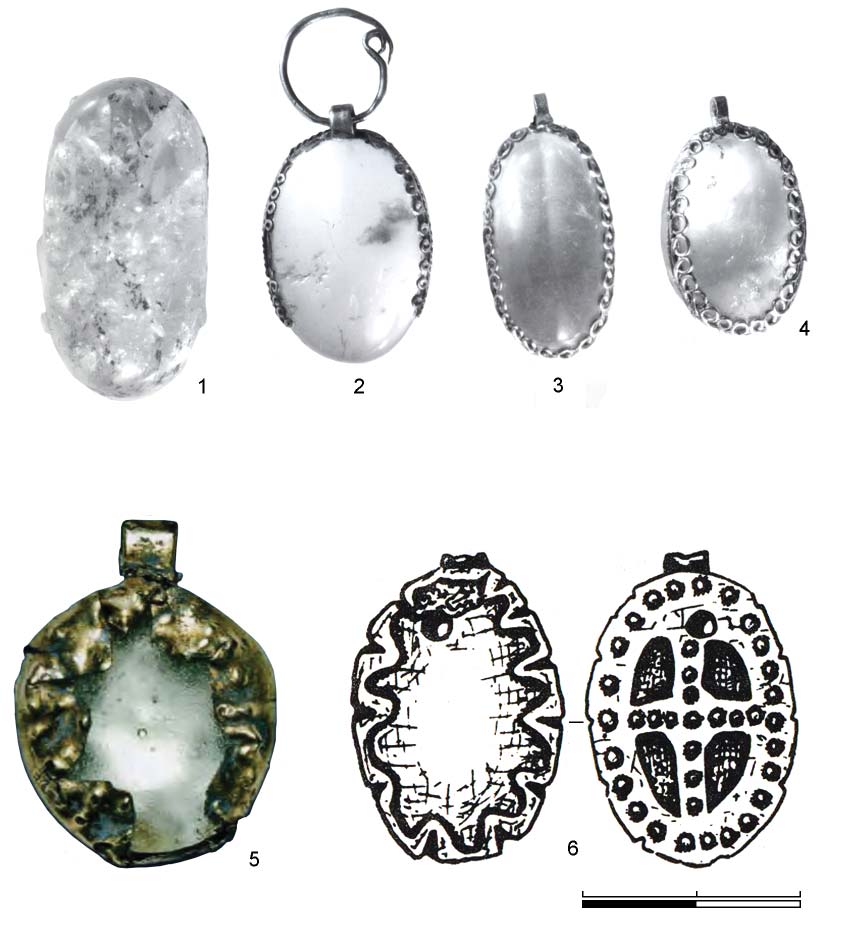ON THE ORIGINS OF A JEWELRY SET FROM THE BURIAL OF A NOBLE KUMAN WOMAN IN BALOTA PUSZTA (KISKUNHALAS, HUNGARY)
Keywords:
Eastern and Central Europe, Hungary, 13th century, grave goods, jewelry, cultural traditionsAbstract
The article considers a rich and diverse set of fi ndings from Balota puszta (Hungary) associated with a female burial dating back to 13th century. A study of these objects allowed to identify individual groups of items characterizing the hypothetical origins of the elements of the funerary costume belonging to a noble Kuman woman. A silver torque, plate bracelets, gilded rings of a horn-shaped headdress, a medallion with a crystal insert and a ritual wand are associated with the period when Kuman tribes populated the East-European territory. The tradition of decorating the costume with plaques was probably inherited by the Kumans from the Hungarians. At the same time, a specifi c decoration system of a number of items (bracelets, medallion and plaques) indicates that they may have been manufactured by the single artisan in Central Europe. This is also indicated by the fact that similar fi ligree decoration is refl ected in the design of the wand support representing the foundation of a liturgical item of West-European origin. A buckle, a signet ring and ornaments with pseudo-granulated beads are characteristic of the costume worn by the population of the Carpathian-Balkan region in the 13th–14th centuries. In general, the inventory of the burial represents a combination of several
cultural traditions.
References
Колекції Наукових фондів Інституту археології НАН України. Каталог / Ред. Н.О. Сон. Киïв: Академперіодика, 2007. 356 с.
Комар О.В. Схiднi слов’яни та кочовики степу // Україна: хронологiя розвитку. Давнi слов’яне. Київська Русь. Том 2 / Гол. ред. П.П. Толочко. Кïев: КРИОН, 2009. С. 450–486.
Пескова А.А., Рябцева С.С. Медальоны с хрустальными вставками в составе социально-престижного убора населения юго-западных регионов Древней Руси // Stratum plus. 2018. № 5. (в печати)
Плетнева С.И. Древности черных клобуков / САИ. Вып. Е1-19. Москва: Наука, 1973. 96 c.
Плетнева С.И. Печенеги, торки, половцы // Степи Евразии в эпоху средневековья / Археология СССР. / Отв. ред. С.А. Плетнёва. М.: Наука, 1981. С. 213–221.
Самоквасов Д. Могилы русской земли. Описание археологических раскопок и собрания древностей. Москва: Синодальная Типография, 1908. 276 c.
Федоров-Давыдов Г.А. Кочевники Восточной Европы под властью золотоордынских ханов: Археологические памятники. Москва: Издательство МГУ, 1966. 276 c.
Свешников И.К. Древнерусский город Звенигород и его торговые связи с Востоком // Славянская археология 1990: Раннесредневековый город и его округа. Материалы по археологии России. Вып. 2 / Ред. В.В. Седов и А.В. Чернецов. Москва: Институт археологии РАН, 1995. С. 43–57.
Хойновский И.А. Краткие археологические сведения о предках славян и руси, и опись древностей, собранных мною, с объяснёнными XX таблицами рисунков. Вып. I. Киев: Типография императорского университета св. Владимира, 1896. 221 с.
Чхаидзе В.Н. Детали женского головного убора из погребений кочевников Восточноевропейской равнины XIII – XIV веков // Памятники средневековой археологии Восточной Европы. К юбилею М.Д. Полубояриновой / Отв. ред. А.В. Чернецов. М.: Институт археологии РАН, 2017. С. 218–234.
Швецов М.Л. Багате кочiвницьке поховання з Донбасу // Археологiя. 1974. №13. C. 93–98.
Dumitriu L. 2001. Der Mittelalterliche Schmuck des unteren Donaugebietes im 11-15 Jahrhundert. Bucureşti: MNIR.
Hatházi G. 2005. Sírok, kincsek, rejtélyek. Kiskunhalas: Print 2000 Nyomda KFT. Kecskemét.
Oţa S., Georgescu M. 2015. Cercei decoraţi cu pandantive ornamentate cu pseudogranule. In C. Croitoru, G.D. Hânceanu (eds.). Miscellanea Historica et Archaeologica in Honorem Vasile Ursachi octogenarii. Braila: Editura Istros a Muzeului Brailei „Carol” I, 373–392.
Pálóczi Horváth A. 2014. Keleti Népek a Középkori Magyaroaszágon. Besenyök, úzok, kunok és jászok müvelödéstörténeti emlékei. Budapest: Piliscsaba, 2014. 326 old.
Vargha М. 2015. Hoards, grave goods, jewellery Objects in hoards and in burial contexts during the Mongol invasion of Central-Eastern Europe. In Archaeolingua Central European Archaeological Heritage Series 8. Oxford: Archaeopress Archaeology.

Downloads
Published
How to Cite
Issue
Section
License
Copyright (c) 2018 S. S. Ryabtseva, A. A. Peskova

This work is licensed under a Creative Commons Attribution-NonCommercial 4.0 International License.







